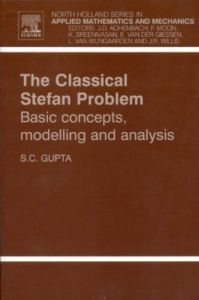This volume emphasises studies related to
classical Stefan problems. The term "Stefan problem" is
generally used for heat transfer problems with
phase-changes such
as from the liquid to the solid. Stefan problems have some
characteristics that are typical of them, but certain problems
arising in fields such as mathematical physics and engineering
also exhibit characteristics similar to them. The term
``classical" distinguishes the formulation of these problems from
their weak formulation, in which the solution need not possess
classical derivatives. Under suitable assumptions, a weak solution
could be as good as a classical solution. In hyperbolic Stefan
problems, the characteristic features of Stefan problems are
present but unlike in Stefan problems, discontinuous solutions are
allowed because of the hyperbolic nature of the heat equation. The
numerical solutions of inverse Stefan problems, and the analysis of
direct Stefan problems are so integrated that it is difficult to
discuss one without referring to the other. So no strict line of
demarcation can be identified between a classical Stefan problem
and other similar problems. On the other hand, including every
related problem in the domain of classical Stefan problem would
require several volumes for their description. A suitable
compromise has to be made.
The basic concepts, modelling, and analysis of the classical
Stefan problems have been extensively investigated and there seems
to be a need to report the results at one place. This book
attempts to answer that need. Within the framework of the
classical Stefan problem with the emphasis on the basic concepts,
modelling and analysis, it tries to include some weak
solutions and analytical and numerical solutions also. The main
considerations behind this are the continuity and the clarity of
exposition. For example, the description of some phase-field
models in Chapter 4 arose out of this need for a smooth transition
between topics. In the mathematical formulation of Stefan
problems, the curvature effects and the kinetic condition are
incorporated with the help of the modified Gibbs-Thomson relation.
On the basis of some thermodynamical and metallurgical
considerations, the modified Gibbs-Thomson relation can be
derived, as has been done in the text, but the rigorous
mathematical justification comes from the fact that this relation
can be obtained by taking appropriate limits of phase-field
models. Because of the unacceptability of some phase-field models
due their so-called thermodynamical inconsistency, some consistent
models have also been described. This completes the discussion of
phase-field models in the present context.
Making this volume self-contained would require reporting and
deriving several results from tensor analysis, differential
geometry, non-equilibrium thermodynamics, physics and functional
analysis. The text is enriched with appropriate
references so as not to enlarge the scope of the book. The proofs
of propositions and theorems are often lengthy and different from
one another. Presenting them in a condensed way may not be of much
help to the reader. Therefore only the main features of proofs
and a few results have been presented to suggest the essential
flavour of the theme of investigation. However at each place,
appropriate references have been cited so that inquisitive
readers can follow them on their own.
Each chapter begins with basic concepts, objectives and the
directions in which the subject matter has grown. This is followed
by reviews - in some cases quite detailed - of published works. In a
work of this type, the author has to make a suitable compromise
between length restrictions and understandability.
In Collection
#3707
Read It:
Yes
#3707
Read It:
Yes
Heat - Transmission, Boundary value problems
|
|
||||||||||||||||||
